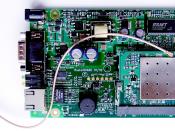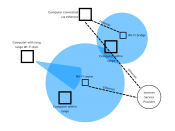The history of wireless communication is fairly long, but the recent emergence of wireless networking has the potential to revolutionize the way people think about wireless communication in regards to computing. The confluence of mobile phone communication and wireless networking emphasizes this point especially, since there seems to be a present shift towards including different communication devices to work together in a wireless environment. Wireless networking is basically a way for two or more computers to communicate without using traditional cords and cables. This technology is supplied by a number of companies operating for the most part under the industry standard of 802.11b. Wireless networking is in many cases quicker than more traditional methods of access, is becoming increasingly affordable, and is also being made available in various public areas such as airports to enhance the medium's convenience and adaptability. Companies and institutions that employ wireless networking in-house generally do so to increase the convenience of laptop interface, and to cut down on the confusing tangle of wiring that more traditional networking options often presents.
Other companies use the system to improve shipping interfaces. Many current writers in the technology field are optimistic about wireless networking, seeing it as a dynamic and constantly changing type of networking that is capable of providing quick, easy access between computers in virtually any sort of application.
At the start of this technology's development, wireless networks were not available for such broad applications because they were slower, more expensive, and often the result of a necessity driven by risk or architectural drawbacks. For example, if a building's walls did not support the cabling necessary to set up a network, a more costly and less speedy wireless connection would have to be developed with the possibility of a loss in productivity. At the present, however,


